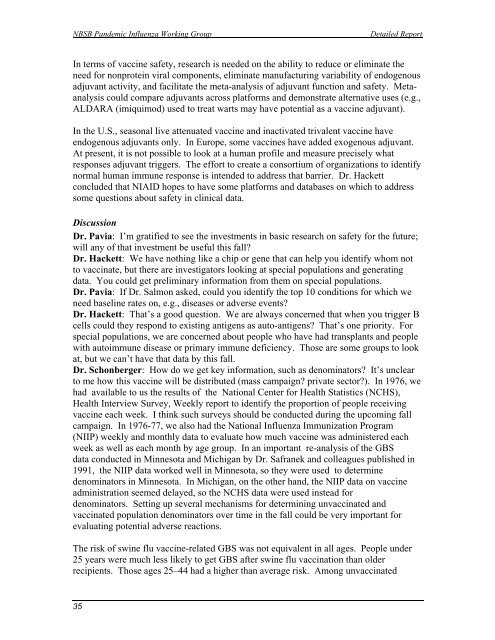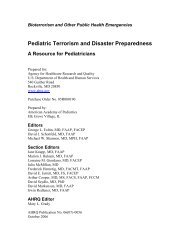H1N1 COUNTERMEASURES STRATEGY AND ... - PHE Home
H1N1 COUNTERMEASURES STRATEGY AND ... - PHE Home
H1N1 COUNTERMEASURES STRATEGY AND ... - PHE Home
You also want an ePaper? Increase the reach of your titles
YUMPU automatically turns print PDFs into web optimized ePapers that Google loves.
NBSB Pandemic Influenza Working Group<br />
Detailed Report<br />
In terms of vaccine safety, research is needed on the ability to reduce or eliminate the<br />
need for nonprotein viral components, eliminate manufacturing variability of endogenous<br />
adjuvant activity, and facilitate the meta-analysis of adjuvant function and safety. Metaanalysis<br />
could compare adjuvants across platforms and demonstrate alternative uses (e.g.,<br />
ALDARA (imiquimod) used to treat warts may have potential as a vaccine adjuvant).<br />
In the U.S., seasonal live attenuated vaccine and inactivated trivalent vaccine have<br />
endogenous adjuvants only. In Europe, some vaccines have added exogenous adjuvant.<br />
At present, it is not possible to look at a human profile and measure precisely what<br />
responses adjuvant triggers. The effort to create a consortium of organizations to identify<br />
normal human immune response is intended to address that barrier. Dr. Hackett<br />
concluded that NIAID hopes to have some platforms and databases on which to address<br />
some questions about safety in clinical data.<br />
Discussion<br />
Dr. Pavia: I’m gratified to see the investments in basic research on safety for the future;<br />
will any of that investment be useful this fall?<br />
Dr. Hackett: We have nothing like a chip or gene that can help you identify whom not<br />
to vaccinate, but there are investigators looking at special populations and generating<br />
data. You could get preliminary information from them on special populations.<br />
Dr. Pavia: If Dr. Salmon asked, could you identify the top 10 conditions for which we<br />
need baseline rates on, e.g., diseases or adverse events?<br />
Dr. Hackett: That’s a good question. We are always concerned that when you trigger B<br />
cells could they respond to existing antigens as auto-antigens? That’s one priority. For<br />
special populations, we are concerned about people who have had transplants and people<br />
with autoimmune disease or primary immune deficiency. Those are some groups to look<br />
at, but we can’t have that data by this fall.<br />
Dr. Schonberger: How do we get key information, such as denominators? It’s unclear<br />
to me how this vaccine will be distributed (mass campaign? private sector?). In 1976, we<br />
had available to us the results of the National Center for Health Statistics (NCHS),<br />
Health Interview Survey, Weekly report to identify the proportion of people receiving<br />
vaccine each week. I think such surveys should be conducted during the upcoming fall<br />
campaign. In 1976-77, we also had the National Influenza Immunization Program<br />
(NIIP) weekly and monthly data to evaluate how much vaccine was administered each<br />
week as well as each month by age group. In an important re-analysis of the GBS<br />
data conducted in Minnesota and Michigan by Dr. Safranek and colleagues published in<br />
1991, the NIIP data worked well in Minnesota, so they were used to determine<br />
denominators in Minnesota. In Michigan, on the other hand, the NIIP data on vaccine<br />
administration seemed delayed, so the NCHS data were used instead for<br />
denominators. Setting up several mechanisms for determining unvaccinated and<br />
vaccinated population denominators over time in the fall could be very important for<br />
evaluating potential adverse reactions.<br />
The risk of swine flu vaccine-related GBS was not equivalent in all ages. People under<br />
25 years were much less likely to get GBS after swine flu vaccination than older<br />
recipients. Those ages 25–44 had a higher than average risk. Among unvaccinated<br />
35
















